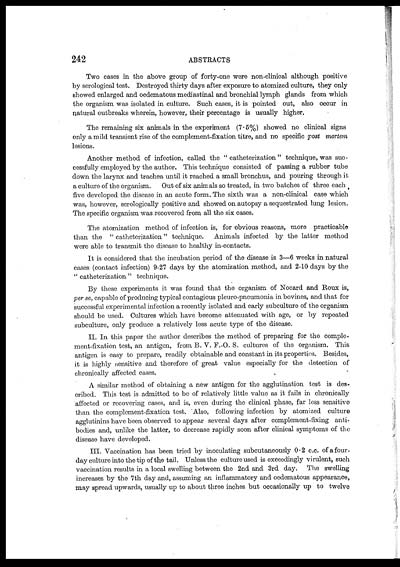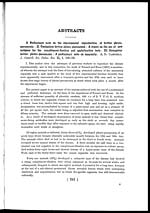Medicine - Veterinary > Veterinary colleges and laboratories > Indian journal of veterinary science and animal husbandry > Volume 9, 1939 > Original articles > Abstracts
(136) Page 242
Download files
Individual page:
Thumbnail gallery: Grid view | List view

242 ABSTRACTS
Two cases in the above group of forty-one were non-clinical although positive
by serological test. Destroyed thirty days after exposure to atomized culture, they only
showed enlarged and oedematous mediastinal and bronchial lymph glands from which
the organism was isolated in culture. Such cases, it is pointed out, also occur in
natural outbreaks wherein, however, their percentage is usually higher.
The remaining six animals in the experiment (7.5%) showed no clinical signs
only a mild transient rise of the complement fixation titre, and no specific post mortem
lesions.
Another method of infection, called the "catheterization" technique, was suc-
cessfully employed by the author. This technique consisted of passing a rubber tube
down the larynx and trachea until it reached a small bronchus, and pouring through it
a culture of the organism. Out of six animals so treated, in two batches of three each
five developed the disease in an acute form. The sixth was a non-clinical case which
was, however, serologically positive and showed on autopsy a sequestrated lung lesion.
The specific organism was recovered from all the six cases.
The atomization method of infection is, for obvious reasons, more practicable
than the " catheterization" technique. Animals infected by the latter method
were able to transmit the disease to healthy in-contacts.
It is considered that the incubation period of the disease is 3—6 weeks in natural
cases (contact infection) 9-27 days by the atomization method, and 2-10 days by the
" catheterization " technique.
By these experiments it was found that the organism of Nocard and Roux is,
per se, capable of producing typical contagious pleuro-pneumonia in bovines, and that for
successful experimental infection a recently isolated and early subculture of the organism
should be used. Cultures which have become attenuated with age, or by repeated
subculture, only produce a relatively less acute type of the disease.
II. In this paper the author describes the method of preparing for the comple-
ment-fixation test, an antigen, from B. V. F. O. S. cultures of the organism. This
antigen is easy to prepare, readily obtainable and constant in its properties. Besides,
it is highly sensitive and therefore of great value especially for the detection of
chronically affected cases.
A similar method of obtaining a new antigen for the agglutination test is des-
cribed. This test is admitted to be of relatively little value as it fails in chronically
affected or recovering cases, and is, even during the clinical phase, far less sensitive
than the complement-fixation test. Also, following infection by atomized culture
agglutinins have been observed to appear several days after complement-fixing anti-
bodies and, unlike the latter, to decrease rapidly soon after clinical symptoms of the
disease have developed.
III. Vaccination has been tried by inoculating subcutaneously 0.2 c.c. of a four-
day culture into the tip of the tail. Unless the culture used is exceedingly virulent, such
vaccination results in a local swelling between the 2nd and 3rd day. The swelling
increases by the 7th day and, assuming an inflammatory and oedematous appearance,
may spread upwards, usually up to about three inches but occasionally up to twelve
Set display mode to: Large image | Zoom image | Transcription
Images and transcriptions on this page, including medium image downloads, may be used under the Creative Commons Attribution 4.0 International Licence unless otherwise stated. ![]()
| India Papers > Medicine - Veterinary > Veterinary colleges and laboratories > Indian journal of veterinary science and animal husbandry > Volume 9, 1939 > Original articles > Abstracts > (136) Page 242 |
|---|
| Permanent URL | https://digital.nls.uk/75246844 |
|---|
| Description | Covers articles from 1939. Please note that pagination starts at p.139 and plates at Plate V. |
|---|




